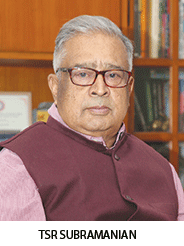 In 1950-51, the total enrolment in higher education was 200,000 students. In the academic year 2014-15, it had risen to 33 million with private institutions playing a major role in the growth of higher education in India. In 2011-12, 64 percent of the total number of colleges and universities were privately promoted and enroled 59 percent of the youth in higher education.
In 1950-51, the total enrolment in higher education was 200,000 students. In the academic year 2014-15, it had risen to 33 million with private institutions playing a major role in the growth of higher education in India. In 2011-12, 64 percent of the total number of colleges and universities were privately promoted and enroled 59 percent of the youth in higher education.
Although the growth in the number of higher education institutions and enrolment is impressive, its record in assuring employment is questionable. An uncomfortable number of graduate and even postgraduate students don’t get jobs connected with their subjects of study despite spending several years in higher education. According to a 2015 study conducted by FICCI, less than 20 percent of the annual output of graduates is readily employable by industry.
There are wide variations in the quality of higher education institutions in India. While some Central government-run and/or aided universities are globally acclaimed for their good quality of education, there are hundreds of privately-run colleges and state government universities which are ill-equipped, and operating with under-qualified staff. The majority of tertiary institutions fall between these two extremes. They vary widely in terms of infrastructure, library and laboratory facilities, quality of teachers and teaching-learning processes. The first step towards reform is to confront the reality that many private universities and colleges, professional and otherwise, flourish under the patronage of influential people backed by money power with little interest in education who take advantage of a lax or corrupt regulatory environment to provide sub-standard education at high prices.
With demand for technical education far exceeding the supply of seats — particularly in top-ranked engineering and medical colleges — most state governments conduct special examinations and prepare merit lists of state quota students who receive highly subsidised engineering and medical education in private colleges. This quota averages 50 percent in the states. The remaining seats are left to college managements to fill under discretionary quotas. These are the notorious ‘capitation fee’ seats, on which premia vary according to demand. In some postgraduate medical courses, the premium can be as high as a few crores.
In most states, the fees of government and private colleges are determined by the government, and are kept very low purportedly to provide access to poor and socially disadvantaged students. The controlled fees are unrelated to infrastructure facilities or quality of education provided. Tuition fees thus fixed are often below the cost of education provision. The tacit understanding is that private college managements can make good the deficit by charging capitation fees. Unfortunately, the system assumes that the institution’s management will resort to black-money transactions, and keep two sets of books.
But even as the great majority of private engineering and medical colleges offer sub-standard education at high prices, publicly provided higher education is not only over-subsidised but universal, i.e, not means tested. Thus all students of St. Stephen’s College, Delhi — India’s routinely top-ranked liberal arts college — pay a mere Rs.31,000 per annum as tuition fees which barely covers 10-20 percent of the cost of education. Likewise, despite having doubled recently, tuition fees in the globally acclaimed IITs barely cover 25 percent of actual cost.
Clearly, there’s a need to link issues of ability to pay and a broadly acceptable formula linking fees with actual costs. A meritorious student admitted into an IIT or IIM is a good credit risk and is eligible for an education loan, and as such, must be made to refund the actual cost of her education. The answer is to devise a national education loans programme with subsidies and scholarships restricted to students from economically and socially backward categories. Universal indiscriminate subsidisation in publicly-funded institutions of higher education is a subject crying for reform.
Inadequate linkage with institutional financing coupled with a craze for obtaining degrees without a credible national programme for effective and meaningful vocational training, compounds the problem. In effect, much of the existing weaknesses of India’s higher education system stem from a faulty national educational policy, indeed a lack of a sensible approach to the issue of education reforms.
In the circumstances, major reforms are required to address these issues bedeviling India’s tertiary education institutions. First, full autonomy needs to be given to universities and affiliated colleges to design their curriculums, and introduce new study programmes based on demand. Secondly, the finances of higher education institutions should become open and transparent. Third, the state needs to scrap the system of universal subsidisation of higher education and replace it with a well-structured system of long-term education loans for the majority, and targeted subsidies for students from underprivileged and disadvantaged sections of society.
(T.S.R. Subramanian is a former Union cabinet secretary and chairman of the Committee for Evolution of the New Policy on Education 2016)